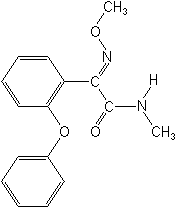-
Common NameMetominostrobin
-
中文通用名苯氧菌胺
-
IUPAC(E)-2-methoxyimino-N-methyl-2-(2-phenoxyphenyl)acetamide
-
CAS(E)-
a-methoxyimino-N-methyl-2-phenoxybenzeneacetamide -
CAS No.133408-50-1
-
Molecular FormulaC16H16N2O3
-
Molecular Structure
-
Category
-
ActivityFungicide.Metominostrobin is a broad-spectrum, systemic fungicide with preventative and curative activity. The product can be applied to foliage or directly to paddy water and has residual activity lasting approximately 50 days. It is recommended to apply Oribright between 10 days before and 10 days after the appearance of initial symptoms of rice blast.Metominostrobin moves acropetally and basipetally in plants
Metominostrobin acts, as other strobilurins, by blocking mitochondrial respiration via inhibition of electron flux through the cytochrome bc1 complex. It exhibits fungistatic activity in in vitrostudies and respiration can be restored after incubation with the product through induction of cyanide-resistant respiration. However, the observed fungicidal effect in the field suggests that the fungistatic activity of metominostrobin is enhanced by a separate mechanism that is thought to involve the inhibition of the cyanide resistant pathway by flavonoid compounds either existing or induced in rice plants. -
CropUseCropUses:
cereals, cucumbers, onions, peppers, pome fruits, potatoes, rice, tomatoes, vegetables
Rice
150-180 g ai/ha
Small-grain cereals
210-840 g ai/ha
Vegetables
150-500 g ai/ha
-
Disease SpectrumBrown spot, rice blast, sheath blight
-
FormulationGR = Granule
-
Physical PropertiesMolecular weight:284.3; Physical form:White crystals. Density:1.27-1.30 (20 °C); Composition:>97% pure. Melting point:87-89 °C; Flash point:226 °C (Seta flash tester); Vapour pressure:0.018 (25 °C, gas saturation method); Partition coefficient(n-octanol and water):logP = 2.32 (20 °C); Solubility:In water 0.128 g/l (20 °C). In dichloromethane 1380, chloroform 1280, dimethyl sulfoxide 940 (all in g/l, 25 °C).; Stability:Stable to heat, and to acidic and alkaline media. Slightly unstable to light.;
-
ToxicologyOral:Acute oral?
?LD50 ?for male rats 776, female rats 708 / . Percutaneous:Acute percutaneous 50 for male and female rats >2000 /kg. Not a skin irritant; slight eye irritant (rabbits, 15% GR formulation). Not a skin sensitiser (15% GR formulation). Inhalation: -
Environmental ProfileEcotoxicology:?
Algae:LD50(72 h) for Chlorella vulgaris 51.0 /l; (72 h) 10 /l.Bees: LD50 (48 h) >100 mg/bee.Birds:Acute oral 50 for mallard ducks >5200 .Daphnia: LC50 (48 h) for D. pulex 14.0 /l; (24 h) 22.3 /l.Fish: LC50? (96 h) for carp 18.1 /l.Worms: LC50? (14 d) for Eisenia foetida 114 / ; (14 d) 56.2 / .Other beneficial spp.: 50 (5 d) for silkworms 250 .?
Environmental fate:?
Soil:Soil50 98 d (aerobic). -
Transport InformationHazard Class:O (Obsolete as pesticide, not classified)
Porduct NewsMore
Ihara registers Fusão fungicide in Brazil
Brazil Anvisa approves Sumitomo/Ihara’s fungicide metominostrobin
Sumitomo Corp. acquires right from Bayer to market fungicide metominostrobin in Japan

 0
0 Subscribe
Subscribe
